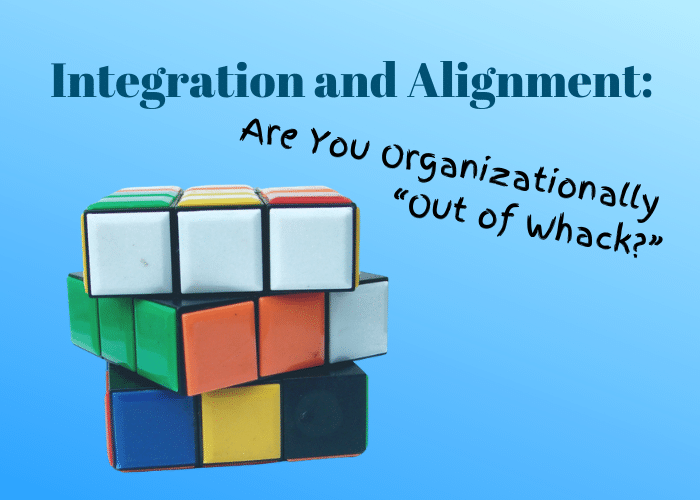
Integration and Alignment: Are you Organizationally “Out of Whack?”
Do you ever wake up feeling out of sorts? Unexplained aches and pains. Just feeling a little off. It’s not awful, but it is distracting and annoying. It might keep you from being fully present or as active as usual. Maybe you just slept wrong last night. But if it keeps happening, there’s usually something bigger going on (how old is that mattress, anyway?).
The same thing happens to organizations.
Recurring issues and challenges keep the organization from being all it can be. You’re not doing anything wrong. Even the best-run organizations get out of alignment as circumstances change over time.
What’s important – now more than ever before – is to refuse to live with these kinds of organizational aches and pains. Your mission and those you serve need your organization to be in tip-top shape and that means finding the root cause and addressing it effectively.
We pay a lot of attention to organizational alignment in our consulting work. Actually, the Integrated Strategy for Success and Sustainability that underlies all our work speaks to the potency of aligning identity, constituents, and capacity.
The Consequences of Being Out of Alignment
Here’s an example. A large, decentralized organization had developed many different programs and services over its 100+ year history. Each program was organized in its own silo and that worked well when the organization was younger and smaller.
But as it grew, these siloes made the organization fragmented. As a consequence, every program did outreach on its own; the organization lacked a cohesive brand or central message; the community knew individual programs but didn’t see the overall organization; furthermore, clients had no way to easily access the full suite of available services. After receiving the analysis, the CEO immediately understood how this fragmentation led to inefficient use of resources and decreased the effectiveness of programs and services.
“If you believe in the simple concept — that the way you organize your work makes all the difference in the world —there is an alternative to . . . fragmentation. Rather than a series of discrete steps, work becomes an end-to-end continuum. People no longer focus entirely on their own jobs with no notion of how their work affects their colleagues’ ability to do their jobs or even the customer. Instead, they are thinking about the whole and not the parts, about outcomes instead of activities, about the collective rather than the individual. What are now individual fiefdoms meld seamlessly into a unified structure with one goal: customer satisfaction.”
Michael Hammer and Lisa Hershman, Better, Faster, Cheaper, The 9 Levers for Transforming How Work Gets Done
Three Steps to Align and Integrate
Creating a more aligned, integrated organization isn’t complicated. We’ve developed a three-step process guided by organizational data, leadership decisions, and organizational development principles that does just that.
1.Integrated Plan
Form follows function. The integrated plan defines the organization-wide outcomes and strategies your integrated, aligned organization will achieve. (What’s Your Winning Strategy)
2. Alignment Design
The next step is to design the staffing, structure, systems, and culture that align with achieving those organization-wide outcomes. Usually, this step includes reallocating and restructuring resources to align with your goals (not your programs), developing an organization-wide budget, and sharing information in new ways.
3. Change Management
With your plan and design in hand, it’s time to implement. Aligning and integrating an organization is an exercise in managing change. Doing this successfully relies on strong, focused leadership, good communication, building new skills, and willingness to take risks and innovate.
Want to Know More?
These three steps have been ground-tested around the country with organizations and agencies in the fields of public health, healthy aging, human services, and conservation. These experiences have shown how aligning and integrating organizations can cure recurring pain points, lead to more productive use of resources, and improve results and impact.
I have renewed excitement for our work helping organizations become more aligned and integrated and encourage you to take advantage of these resources:
- Read Integration and Alignment, A Systems Change Approach to Organizational Alignment for more details on the three steps
- Call (303 223-4886 x 1) or email (Shelli@nonprofitimpact.com) to arrange a free webinar for your organization or to talk about how to build a more integrated organization

